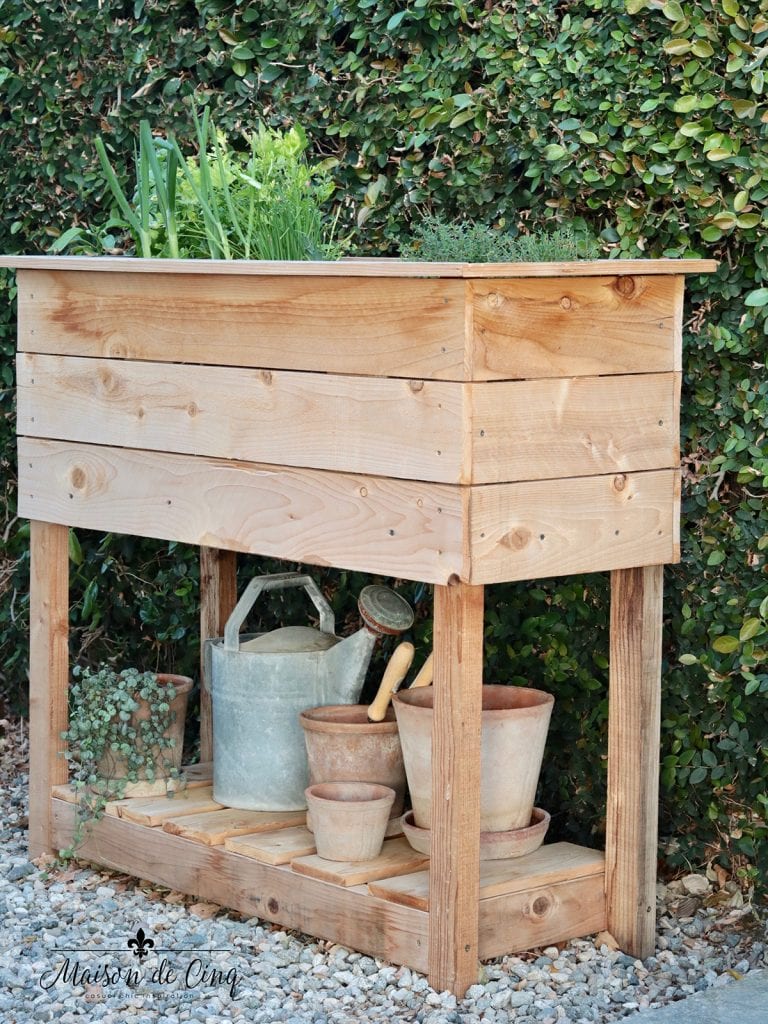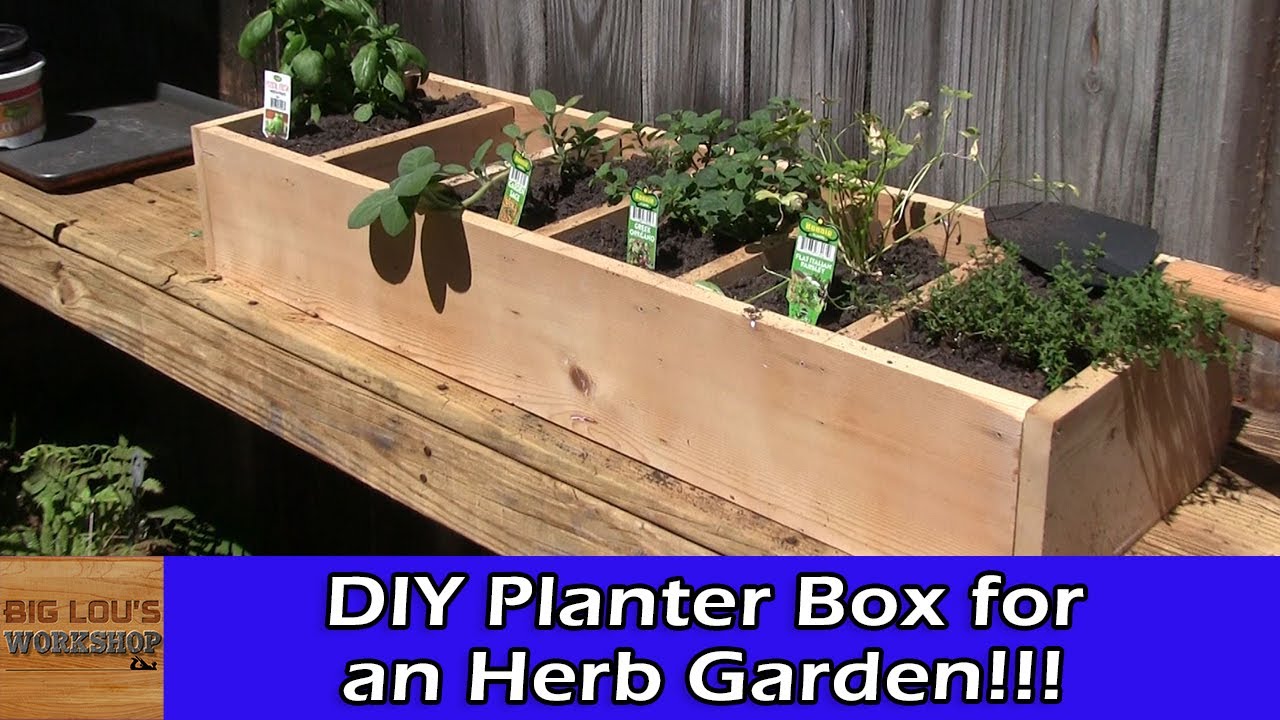To make a herb garden box, first choose a suitable container and fill it with well-draining soil. Then, plant your chosen herbs in the box and provide regular water and sunlight for optimum growth.
Are you interested in growing your own fresh herbs but don’t have a large garden or outdoor space? Creating a herb garden box is the perfect solution. With a herb garden box, you can easily grow a variety of herbs in a compact and manageable space.
Whether you have a small balcony, patio, or even a sunny windowsill, you can enjoy the convenience and flavor of homegrown herbs. In this article, we will guide you step-by-step on how to make a herb garden box, so you can start harvesting your own herbs in no time. So let’s get started with creating your very own herb garden box.

Credit: maisondecinq.com
Materials Needed
To make a herb garden box, you will need wood, either cedar or pine, which can be cut using a hand saw or power saw. Use a measuring tape to ensure accurate dimensions. A drill is necessary to create holes for screws.
Sandpaper will help smooth the surface. Fill the box with soil and then add your chosen herb plants or seeds. A watering can is essential to keep the herbs hydrated. Building a herb garden box requires basic materials and tools, making it an accessible project for anyone interested in starting their own herb garden.
With a bit of care and attention, you can enjoy fresh herbs right at your fingertips.
How to Make a Herb Garden Box: Step by Step Guide
Choosing The Perfect Location
Choosing the perfect location for your herb garden box is crucial for its success. Consider the sun exposure, as herbs thrive with direct sunlight. Also, assess the accessibility to a water source, ensuring the herbs can be easily watered. Evaluate the available space, as herbs need room to grow and spread their roots.
By finding the right location, you can ensure that your herb garden box will flourish and provide you with an abundant supply of fresh herbs. So, take the time to select a spot that offers ample sunlight, a nearby water source, and sufficient space for your herbs to thrive.
With the right location, your herb garden box will be a joy to tend to and will reward you with a bountiful harvest of flavorful herbs.
Building Your Herb Garden Box
Building your herb garden box starts with measuring and cutting the wood. Precision is key in ensuring proper dimensions. Assembling the frame requires careful alignment of the pieces. Each corner must be securely fastened, ensuring the stability of the box.
Don’t forget to drill drainage holes to prevent waterlogging and promote healthy plant growth. By following these steps, you can create a functional and aesthetically pleasing herb garden box. Enjoy the satisfaction of growing your own herbs right at home.
Happy gardening!
Sanding And Finishing
Sanding and finishing your herb garden box is an essential step in the construction process. To ensure a smooth and polished final product, start by smoothing rough edges. This can be done using sandpaper or an electric sander. Be sure to wear protective eyewear and a dust mask while working.
Once all the edges are smooth, it’s time to apply a protective finish. This will not only enhance the appearance of your herb garden box but also protect it from weathering and wear. There are various finishes available, such as paint, stain, or sealant.
Choose one that suits your style and the overall aesthetic you want to achieve. Apply the finish according to the manufacturer’s instructions, allowing sufficient drying time between coats. With careful sanding and finishing, your herb garden box will be not only functional but also visually appealing.
Filling Your Herb Garden Box
Choosing the right soil is crucial for filling your herb garden box. It determines the growth and health of your herbs. Prepare the soil by removing any rocks or debris and loosening it with a garden fork. This helps with drainage and allows the roots to penetrate easily.
Adding compost or fertilizer to the soil provides essential nutrients for your herbs. Compost enriches the soil with organic matter, while fertilizer supplies necessary minerals. Before planting, mix the compost or fertilizer evenly throughout the soil. This ensures that your herbs receive a balanced diet.
Choose a quality compost or a slow-release organic fertilizer for long-term nourishment. With the right soil, your herbs will thrive in the garden box, providing you with delicious flavors and aromas all season long.
Planting Your Herbs

Creating a herb garden box involves several steps to ensure successful planting. Begin by selecting the herbs you want to grow, considering their compatibility with your climate and personal preferences. Arrange the plants strategically within the box, considering their height, growth habit, and sunlight requirements.
Proper spacing is crucial to allow air circulation and prevent overcrowding. Each herb should have enough room to grow and access sufficient nutrients. This will prevent competition for resources and minimize the risk of diseases spreading. By following these steps, you can establish a beautiful and productive herb garden box that will provide fresh ingredients for your culinary adventures.
Caring For Your Herb Garden Box
Caring for your herb garden box involves meeting its watering needs to ensure optimal growth. Proper watering is essential (1) for the herbs to thrive. Monitor the moisture levels (2) and provide water when the top layer of soil feels dry.
Avoid overwatering (3) as it can lead to root rot. (4) pruning and harvesting are crucial tasks to maintain a healthy herb garden box. Regularly trim the plants to encourage bushy growth (5) and harvest the herbs as needed for culinary delights.
(6) protecting your herb garden box from pests and diseases is vital for its longevity. Use organic pest control methods (7) and keep an eye out for any signs of infestation or disease. By following these steps, (8) you can take proper care of your herb garden box and enjoy fresh herbs for your cooking endeavors.
Enjoying Your Fresh Herbs
Creating a herb garden box allows you to enjoy the fresh flavors of herbs in your meals effortlessly. From adding a sprinkle of basil to enhance pasta dishes, to including a few sprigs of rosemary in roasted chicken, fresh herbs elevate the taste of your culinary creations.
Not only does a herb garden box bring convenience to your cooking, but it also allows you to preserve herbs for later use. You can dry herbs for long-term storage, ensuring you have a steady supply throughout the year. Additionally, experimenting with different herb combinations adds a layer of excitement to your cooking.
Try mixing mint and lime in fruity cocktails, or blend thyme and lemon with roasted vegetables. With a herb garden box, you can savor the joys of fresh herbs in every meal, all year round.
Troubleshooting Common Issues

Troubleshooting common issues in your herb garden box is essential for maintaining healthy plants. Yellowing leaves can be a sign of various problems. Avoid over or under-watering by striking a balance in the moisture levels. Pests and diseases may also contribute to leaf discoloration.
Regularly inspect your plants for any signs of infestation or infection. Identify the problem early and take necessary steps to mitigate it. Consider using organic pest control methods or consulting with a professional if needed. By addressing these common issues, you can ensure a thriving herb garden box filled with vibrant and green foliage.
Ultimately, a little care and attention go a long way in preserving the health of your plants.
Frequently Asked Questions For How To Make A Herb Garden Box
How Do I Build A Herb Garden Box?
To build a herb garden box, start by selecting a suitable location, considering sunlight and drainage. Next, choose the right materials like cedar, then cut and assemble the box. Add a layer of gravel for drainage, fill with nutrient-rich soil, and plant your chosen herbs.
Water regularly and enjoy your fresh herbs all season long!
What Herbs Are Best For A Small Garden Box?
When choosing herbs for a small garden box, consider those that don’t require excessive space to grow. Some great options include basil, parsley, thyme, mint, and chives. These herbs are easy to grow, compact, and will thrive in a confined space.
They’ll provide you with a plentiful harvest right at your fingertips.
Can I Grow Herbs In A Sunny Apartment?
Absolutely! Growing herbs in a sunny apartment is not only possible, but it’s also a great way to enjoy fresh flavors. Find a sunny window or balcony where your herbs can receive at least 6 hours of sunlight daily. Use containers with proper drainage, select suitable herbs, and provide regular care such as watering and fertilizing for successful herb growth.
How Often Should I Water My Herb Garden Box?
The watering frequency for your herb garden box will vary depending on factors such as the weather and the specific herbs you are growing. As a general rule, check the soil moisture regularly and water when the top inch feels dry.
Ensure proper drainage to avoid waterlogged roots, as overwatering can harm herb plants.
Can I Use Recycled Materials To Build A Herb Garden Box?
Yes, you can use recycled materials to build a herb garden box. Upcycling old wooden crates, pallets, or even repurposing a vintage container can be a sustainable and creative way to construct your herb garden. Just ensure the materials are safe, strong, and suitable for planting, and that you provide proper drainage and treatment as needed.
What Are The Best Soil And Fertilizer For Herb Garden Boxes?
For herb garden boxes, use well-draining potting soil to prevent waterlogging. Look for a mix specifically designed for herbs or container gardening, which will provide the right balance of nutrients. As for fertilizer, opt for an organic option like compost or a slow-release herb-specific blend which will provide the necessary nutrients throughout the growing season.
Conclusion
Creating your own herb garden box is an excellent way to bring nature into your home and elevate your culinary creations. With just a few materials and a little bit of time, you can build a functional and aesthetically pleasing herb garden box that will provide you with fresh herbs year-round.
Remember to choose a suitable location for your box, consider the size and type of herbs you want to grow, and provide proper drainage to ensure their healthy growth. Whether you’re a seasoned gardener or just starting out, this diy project offers countless benefits, from saving money to having a convenient supply of flavorful herbs at your fingertips.
So go ahead, get your hands dirty and enjoy the satisfaction of nurturing your own herb garden box. Happy gardening!

